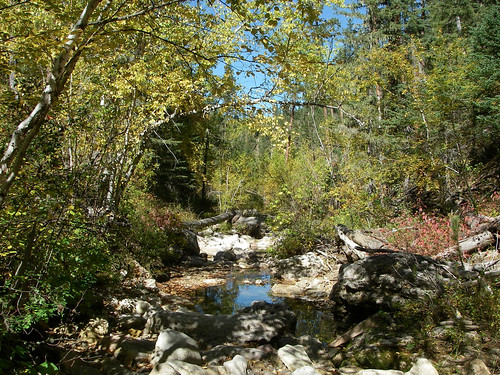
Perhaps it’s just me, but I think many people are relieved to see the fall colors and relish the cool mornings here on the Black Hills National Forest.
It was a long, hot summer in the forests of the U.S. Forest Service’s Rocky Mountain Region. The Black Hills are a forested “island in the plains,” known for its pine-clad hills, which straddle the border of South Dakota and Wyoming. Every fall I am asked what is wrong with the ponderosa pine (Pinus ponderosa var. scopulorum) trees, which appear only half-green. Fall needlecast is natural for many conifers, including ponderosa pine. The trees shed their oldest leaves each fall, but the leaves at the branch tips remain green. Pine trees that lose their newer leaves at the branch tips may be stressed or diseased.
While the Black Hills may be recognizable for their extensive ponderosa pine forests, many other plant communities interest me here on the Northern Hills Ranger District. The northern Black Hills located south of Spearfish, S.D., are rich with native plant diversity and wildlife habitat that display an array of beautiful and subtle changes in the fall. Scenic drives on the Peter Norbeck Scenic Byway and the Spearfish Canyon Scenic Byway make viewing the breathtaking fall colors as easy as turning the car key in the ignition. But when I get into the woods during the lovely fall days, I like to explore some more remote country up close.

This brightgreen spleenwort (Asplenium trichomanes-ramosum) was found growing out of a rock wall. This fern is uncommon in South Dakota, and is restricted to a few western counties where it can be found growing on limestone cliffs and boulders in the Black Hills.
The northern and eastern fronts of the Black Hills uplift are incised with hundreds of small draws and tributaries to the area’s larger streams, such as Spearfish Creek and Elk Creek. These small, rich draws are replete with a diversity of plants normally associated with eastern and boreal forest types that lie well to the north and east of the Black Hills.
A superb example of this community type is conserved in the Bear and Beaver Gulches Botanical Area located on the Northern Hills Ranger District of the Black Hills National Forest.
Here, the falling leaves collect in spring-fed streams and pools, reflecting the multi-layered riparian forest along the stream banks. The early summer rush of the snow-fed, creek flow is a distant memory at this time of year.
The U.S. Forest Service is waiving fees at most of its day-use recreation sites over the Veterans Day holiday weekend, Nov. 10-12. The fee waiver days support the goals of President Obama’s America’s Great Outdoors initiative and First Lady Michelle Obama’s Let’s Move! Outside. To find a forest near you, check out our Forest Locator Map!

